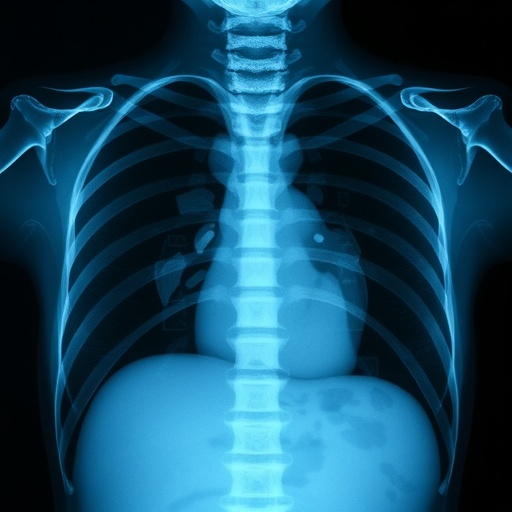In recent years, the field of pediatric radiology has witnessed considerable advancements, particularly in the way neonatal chest radiographs are understood and executed. A fresh study conducted by Arulnathan, Jackson, and Howitt delves into the intricacies of anatomical marker placement in mobile neonatal chest radiographs, addressing both the challenges posed by standard medical practices and the practical implications on patient care.
The necessity for precision in neonatal radiography cannot be overstated. Newborns, especially those admitted to neonatal intensive care units (NICUs), face unique medical circumstances, and any misstep in radiographic planning can have significant repercussions. The authors emphasize that proper marker placement serves not merely as an academic exercise, but as a fundamental aspect of ensuring accurate diagnoses and effective treatment strategies.
Advances in technology have augmented the functionality of mobile radiography units, allowing for improved imaging quality. However, this also brings forth a set of challenges, particularly when dealing with vulnerable populations such as neonates. The study outlines how the intricate positioning of anatomical markers can be instrumental in enhancing the clarity of radiographic images while simultaneously adhering to the stringent standards set forth by radiological guidelines.
As Arulnathan and his colleagues point out, the existing protocols sometimes prove cumbersome in real-world clinical settings. The tension between adhering to established standards and meeting the immediate needs of clinical practice often leads to a compromise that might hinder the imaging process. This research endeavors to strike a balance between these opposing forces, offering insights that may refine current methodologies.
The significance of anatomical marker placement can also be seen through its impact on the interpretation of results. In medical imaging, clarity and context are vital. An incorrectly placed marker can lead to misinterpretation of a radiograph, thereby jeopardizing the medical decision-making process. By exploring alternative practices and innovative techniques for marker placement, the authors suggest that we can enhance the overall efficacy of neonatal imaging.
Furthermore, the study highlights the necessity for ongoing training and education for radiology technicians and medical professionals. As the authors argue, understanding the principles behind marker placement—an often-overlooked aspect of radiographic practice—can lead to better outcomes for patients. This emphasis on education is crucial, especially as technology continues to evolve and reshape the landscape of medical imaging.
In addressing the existing literature, the study goes beyond mere critique—it proactively proposes a series of potential solutions aimed at mitigating the complexities in mobile neonatal radiography. These proposed adjustments challenge current norms and invite discourse within the medical community, encouraging a collective re-evaluation of the guidelines governing radiological practices in neonates.
Another intriguing aspect of the study is the exploration of patient-centered care through imaging. Neonates, being particularly sensitive to interventions, necessitate an approach that minimizes stress and discomfort. The placement of anatomical markers, when approached thoughtfully, can be aligned with the broader goal of providing an overall comforting medical experience for young patients and their families—a pivotal factor that should never be overlooked.
The implications of enhanced marker placement techniques extend beyond individual patient experiences to broader healthcare outcomes. With improved accuracy, the chances of correct diagnoses increase, leading to timely and effective treatment strategies. This, in turn, reinforces the essential role radiology plays in the continuum of pediatric care, making a compelling case for an integrated approach to medical imaging.
Interestingly, the authors also engage with the ethically sensitive questions surrounding consent and parental involvement in neonatal imaging procedures. Given that neonates are unable to voice their needs or concerns, the researchers highlight the importance of involving parents in the decision-making process regarding radiographic practices. This engagement not only reassures parents but also fosters a collaborative healthcare environment that respects family values.
As the healthcare landscape continues to shift towards evidence-based practice, the approach taken by Arulnathan and his colleagues becomes all the more relevant. By advocating for a nuanced understanding of anatomical marker placement, they contribute significantly to the ongoing discourse surrounding best practices in neonatal radiography. This study stands as a testament to the importance of research in driving forward the standards of care.
The study acknowledges that fully implementing these recommendations will require additional resources and training. However, the potential benefits make this an endeavor worth pursuing. The authors call upon healthcare systems to invest in training programs that better equip medical professionals with the skills needed to adapt to evolving practices, thereby ultimately benefiting neonatal patient care.
As we move forward, it is imperative for the medical community to continuously assess and refine existing practices, ensuring they are truly reflective of patients’ needs and medical realities. This study paves the way for future research that could further enhance the field, ultimately leading to improved outcomes for one of society’s most vulnerable populations: newborns.
In conclusion, the work of Arulnathan, Jackson, and Howitt on the placement of anatomical markers in mobile neonatal chest radiographs is a significant contribution to pediatric radiology. Their findings illuminate the essential relationship between standards and practical execution, emphasizing that proper marker placement is not merely a detail but a crucial element of effective medical imaging that can considerably impact neonatal care.
Subject of Research: Anatomical marker placement in mobile neonatal chest radiographs
Article Title: Anatomical marker placement in mobile neonatal chest radiographs: navigating standards and practicality
Article References:
Arulnathan, E., Jackson, M. & Howitt, B. Anatomical marker placement in mobile neonatal chest radiographs: navigating standards and practicality.
Pediatr Radiol (2025). https://doi.org/10.1007/s00247-025-06449-2
Image Credits: AI Generated
DOI: https://doi.org/10.1007/s00247-025-06449-2
Keywords: Neonatal radiography, anatomical markers, chest radiographs, pediatric radiology, medical imaging standards.




